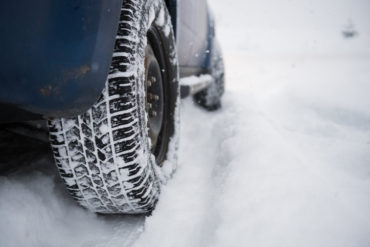
Almost half of B.C. drivers using winter tires this year: ICBC survey
October 31, 2017 by Canadian Underwriter
Print this page Share
Nearly half (48%) of polled drivers in British Columbia “plan to or already have put winter tires on their vehicle in anticipation of another heavy winter this year,” the Insurance Corporation of British Columbia (ICBC) reported on Monday.
 The survey was conducted earlier this month with an ICBC customer advisory panel of 1,147 respondents.
The survey was conducted earlier this month with an ICBC customer advisory panel of 1,147 respondents.
Snow is in the forecast for parts of B.C. this week and “significantly more” Lower Mainland drivers reported being unprepared for driving in the conditions last winter as compared to drivers in other regions of the province, ICBC said in a press release. “Lower Mainland drivers also reported they were significantly more nervous about driving in both snowy and icy conditions,” ICBC reported.
With last winter’s snowy and icy weather, serious crashes involving injury or death increased by 10% in B.C. compared to 2015 due to drivers going too fast for the road conditions, ICBC said in the release. The statistic involves casualty crashes where at least one person was injured or killed; the police data compares 2016 to 2015.
Almost half of those surveyed (47%) witnessed a crash during the winter weather last year and one-quarter admitted to experiencing at least one ‘near miss’ on the road. As well, ICBC said in the release, in the Lower Mainland, casualty crashes due to driving too fast for the conditions increase by 21% every year as the weather worsens throughout fall (crashes where at least one person was killed or injured; compares October to December using police data (annual average from 2012 to 2016)).
According to the survey, drivers’ top concerns this winter are other drivers who don’t slow down or adjust their driving and “drivers who don’t know how to drive in snow and ice.”
ICBC and police are appealing to Lower Mainland drivers to adjust their driving for the conditions they encounter. “In bad weather, slow down, increase your following distance and allow extra travel time,” the release said, adding that police across the province are looking for drivers travelling at unsafe speeds.
Related: B.C. winter tire rules come into effect on Oct. 1
Certain highways in B.C. require cars and light trucks to use winter tires from Oct. 1 to March 31, with signs posted on these designated highways to advise drivers where and when winter tires are required.
The top challenges for Lower Mainland drivers this winter include:
- Severe winter conditions – After last year’s severe winter, most drivers surveyed stated they had to add extra time to their daily commute and adjust their times of travel. When severe winter conditions arrive, ICBC recommends considering alternatives – take public transit if possible, carpool with a confident driver whose vehicle is equipped for the conditions, take a taxi, work from home or wait until the road crews have cleared major roads;
- Dark and rainy conditions – Focus full attention on the road and use extra caution when approaching intersections. It can be very difficult to see pedestrians and other road users when visibility is reduced;
- Visibility – Consider using headlights when weather is poor and visibility is reduced – not only at night – to help see ahead and be seen by other drivers. Daytime running lights usually don’t activate taillights too;
- Fog – Turn on headlights or use fog lights if it’s very foggy. Use a defroster to keep windows clear and partially roll down a window for more visibility if needed. Use the right edge of the road or road marking as a guide;
- Heavy rain – This can seriously reduce visibility and make road surfaces more difficult to stop on. Make sure wipers are in good condition, slow down and increase following distance to at least four seconds; and
- Icy roads – Drivers surveyed were least confident when driving on icy roads as compared to snow and other conditions. Be aware of black ice when temperatures near freezing. If there is ice build-up on the windshield, there’s likely black ice on the road. Black ice is commonly found in shaded areas, bridges, overpasses and intersections. Slow down and increase following distance.
Have your say: